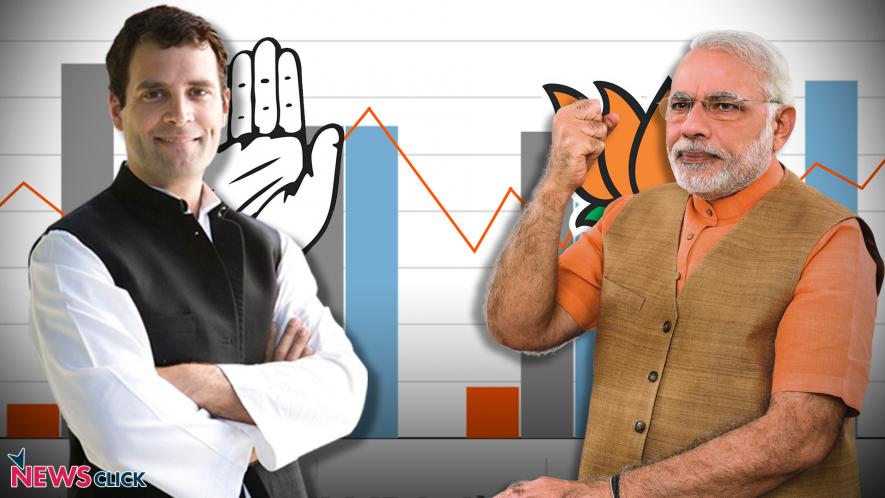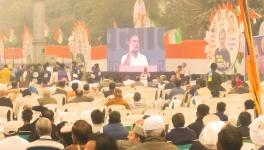Exit Polls Often Go Wrong in Close Elections

Newsclick Image by Aman
For 24x7 news channels it is imperative to create news round the clock. And, to fill up the agonizing wait for elections results, what better device than to have your own mini-poll to predict the election result and go to town over it. So, borrowing Western polling techniques, exit polls have now become a household word in India, with whole companies dedicated to doing such exercises when they are not doing marketing surveys for other companies. But the billion dollar question is: how reliable are these exit polls?
A comparison of actual results with exit poll predictions over the past more than a decade shows that sometimes they are right, sometimes wrong. Usually, sample sizes are a few thousand in a multi-crore electorate, adjustments are made to ‘represent’ different sections of society or regions or sex, or age. In most cases, details of methodology are not easily available so no judgement on their veracity is easily drawn. But some trends can be observed.
The exit polls often fail to throw up a clear picture if the electoral battle is close. They also under-represent opinions of Dalits, tribals, women, poorer sections and people in remote locations. In general, established big parties, especially those favoured by media houses and corporates are given advantage. So, a Lalu Yadav or an Arvind Kejriwal are not favoured, with polling data often adjusted to lessen their performance. And, of course, there is the problem admitted even by pollsters, of converting vote shares to seats. There is no easy formula to convert, say, a 38% vote share into number of seats in a, say, 182 member Assembly.
Be that as it may, here is a quick review of some election results and exit polls in the recent memory.
When exit polls got it wrong:
2004 General Elections: Exit polls predicted that the ruling NDA under PM Atal Bihari Vajpayee would get 230 to 275 seats and cobble together a government again, buoyed by a high decibel “Shining India” poll campaign. But the Congress led UPA got 218 seats beating NDA which got 181. With Left Front support, UPA formed the government.
2009 General Elections: Although exit polls predicted 185 to 205 seats for the ruling UPA, it actually improved its tally and ended up with 262 seats.
2011 Assam Assembly: Ruling Congress was predicted by many pollsters to lose the elections with some giving it as less as 46 seats. But Congress won the election for a record third term getting 78 seats.
2012 Punjab Assembly: Although Congress was predicted to win the elections getting 60 to 68 seats, the Akali-BJP alliance won a third term getting 68 seats.
2015 Bihar Assembly: In a spectacular upset, while all exit polls were predicting a comfortable BJP alliance win, the grand alliance of Nitish Kumar’s JD(U), Lalu Prasad’s RJD and Congress, swept the polls getting 178 seats and forming the government. Later, going against the mandate, Nitish broke the alliance and joined up with BJP.
2016 Tamil Nadu Assembly: While three exit polls predicted a win for the DMK-Congress alliance against the ruling Anna DMK, one poll predicted that the latter would win. Jayalalitha led Anna DMK swept the polls winning 134 seats and a second term.
2017 Punjab Assembly: Although exit polls had correctly predicted a Congress win but almost all polls also predicted that AAP would give it stiff competition, getting as many as 51-57 seats. Ultimately, Congress won a majority with 77 seats but AAP got only 20 seats.
When the exit polls got it more or less right:
2014 General Elections: Most exit polls suggested a win for BJP led NDA, giving it 200 to 300 seats, with one even giving it 331, which turned out to be pretty close to the actual tally of 334. But the exit polls over-estimated the Congress – most had given it 80-100 seats but it ended up with just 44 seats.
2012 Uttarakhand Assembly: Exit polls predicted a close battle and a either a hung house or a slight BJP advantage. It was indeed a close battle but Congress got 32 seats, one more than BJP to form the government with support from independents in the 66 member House.
2014 Maharashtra, Haryana, Jharkhand and J&K Assemblies: Exit polls got it right predicting BJP victories in Maharashtra, Haryana and Jharkhand with a hung house in J&K.
2015 Delhi Assembly: The Aam Admi Party was predicted to win the election getting 35 to 45 seats in the 70 member Assembly. But the exit polls underestimated its popularity because it ended up with 67 seats.
2016 W.Bengal, Assam and Kerala Assemblies: Exit polls correctly called these elections predicting wins for TMC in Bengal, BJP in Assam and LDF in Kerala. However, the seats predicted for TMC and LDF were much lower than what they actually got.
What will happen in the Gujarat and HP elections, results of which are slated to come on 18 December (Monday)? The exit polls are uniformly showing a clear victory for BJP in both states. But, as the above list of misses and hits shows, the question can be settled only once the results are out.
Get the latest reports & analysis with people's perspective on Protests, movements & deep analytical videos, discussions of the current affairs in your Telegram app. Subscribe to NewsClick's Telegram channel & get Real-Time updates on stories, as they get published on our website.
























